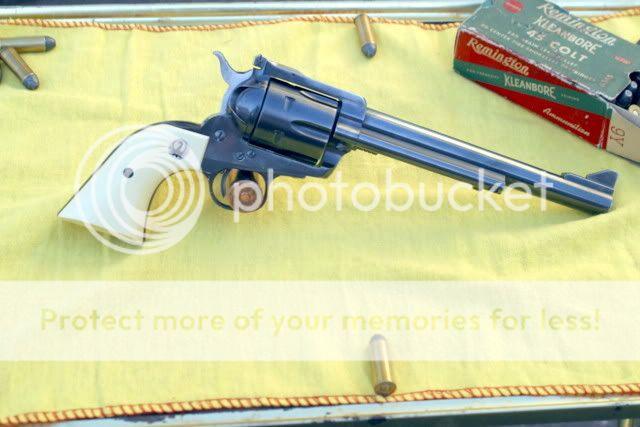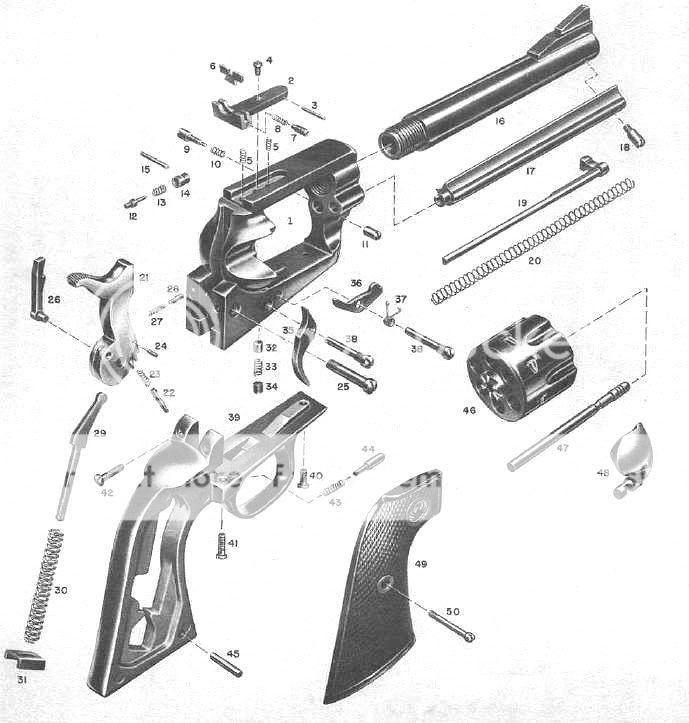HOW TO PROPERLY LOAD AND UNLOAD SINGLE ACTION REVOLVERS
AND PREVENT FULL CIRCUMFERENCE DRAG LINES
Posted on THR 5-27-05 by J Miller
(Edited and updated 12-14-08)
In here is a way to work the action of original "COLT" design single actions to prevent full circumference drag lines. And also some instructions to prevent them on New Model Rugers.
Of course this requires you to first purchase a gun that has NO drag marks, or get your marred cylinder reblued.
To properly load an
OLD STYLE single action revolver, (This includes all unconverted Old Model Rugers, Colts, Colt copies, Remington originals and copies, Great Westerns, Interarms Virginian Dragoons, and many others):
>Pull hammer to half cock.
>Open loading gate.
>Rotate cylinder to load or unload;
LOAD one (1), SKIP one (1), LOAD four (4).
>Close the loading gate
>
Leaving the cylinder in this position, in other words do not turn it, pull the hammer all the way back to full cock and then with your thumb holding the hammer back, pull the trigger and gently lower the hammer to rest.
The hammer will then be resting over an empty chamber.
Doing this will also index the cylinder so that the cylinder latch (bolt) does not drag on the cylinder as it rotates. If for some reason you have to interrupt your loading sequence, or lower the hammer at the wrong time, DO NOT TURN the cylinder as the bolt has risen up and is pressing against it. Turing the cylinder at this time will cause drag marks. To get the cylinder back to it's locked position without creating a drag mark, simply pull the hammer back to full cock and lower it. This will put everything back in sequence.
To demonstrate this for those not familiar with how to handle the old type SA revolvers, I will follow the above directions and then point the gun at a target and pull the trigger. IF I followed the directions all you will hear is a dull thwack. If it fires, I did something wrong. Most of the time the neophytes jump out of their boots when the hammer goes thwack.
To load or unload a
New Model Ruger Blackhawk:
>Flip open the loading gate.
>Load or unload the cylinder.
>Gently hold the cylinder with the flutes centered on both sides of the frame window and close the loading gate. The latch will rise up into its notch almost every time.
>If it has a flute less cylinder, locate the upper most latch (bolt) notches equally on either side of the top strap and close the loading gate. With practice you'll be able to center the cylinder every time.
To load or unload a
New Model Bearcat or a
converted Old Model Ruger SA:
>Pull hammer to half cock.
>Open loading gate.
(
If you want to load five:)
>Rotate cylinder to load or unload;
LOAD one (1), SKIP one (1), LOAD four (4).
>Close loading gate
>
Leaving the cylinder in this position, in other words do not turn it, pull the hammer all the way back to full cock and then with your thumb holding the hammer back, pull the trigger and gently lower the hammer to rest.
The hammer will then be resting over an empty chamber.
(
If you want to load six:)
>Rotate cylinder to load or unload.
>Pull the hammer all the way back to full cock and then with your thumb holding the hammer back, pull the trigger and gently lower the hammer to rest. After the hammer passes the half cock notch you can release the trigger and the transfer bar will drop away from the firing pin.
Notice the cylinder on my Old Model Ruger BH. This is a replacement cylinder, but it has several thousand rounds through it, and untold thousands of dry cycling and hours of handling. Yet, it has NO drag line. So, if you follow my instructions, you can reduce or eliminate the full circumference drag lines on your single action revolvers.
Now, before you assume I'm an arrogant old codger let me tell you this. When I was a teenager in the mid 1960s, I spent many days lounging around The Gun Room, formerly Wades Gun Room in Phoenix, AZ talking to the OLD guys that ran and worked in the place. By old I mean one or two of them were in their 60s then. Meaning they were using single and double action revolvers when the west was still wild. Well it still is, but now we have too many government obstructions to things. Anyway, these experienced shootists taught me the proper way to handle both the single and double action revolvers so the drag lines were prevented. It's not in any book. I don't even think Kuhnhausen has it in any of his books. S&W and Colt don't show it in their owners' manuals, but these methods work. Like JoeD from Handloads.Com said, they won't make sense until you do them as you read the instructions.
Joe


